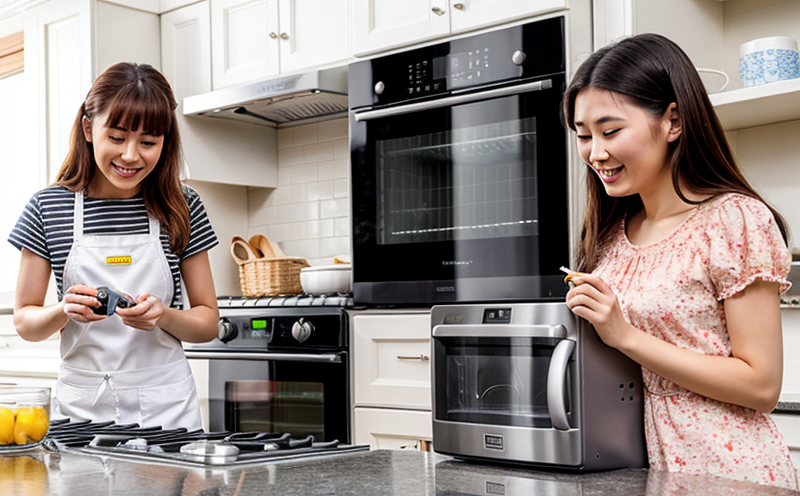IEEE 112 Efficiency Testing for Appliance Motors
The IEEE Standard 112-2017 provides a comprehensive framework for measuring and evaluating motor efficiency. This standard is particularly critical in the household electrical appliances sector where motors are used extensively to power various devices such as refrigerators, dishwashers, washing machines, and air conditioners. The testing methodology outlined in this standard ensures that motors operate efficiently, thereby reducing energy consumption and operational costs.
The IEEE 112-2017 protocol is designed for both synchronous and induction motors with ratings up to 3000 HP (approximately 2245 kW). This makes it applicable to a wide range of household appliances. The testing process involves measuring the input power, output mechanical power, and loss power under specific test conditions that simulate real-world operating scenarios. These conditions are defined by the standard to ensure consistency and reliability.
Motor efficiency is typically expressed as a percentage and is calculated using the formula:
\[ \text{Efficiency} = \frac{\text{Output Mechanical Power}}{\text{Input Power}} \times 100\% \]The standard provides detailed instructions on how to perform these measurements accurately. It also includes considerations for specimen preparation, which involves ensuring that the motor is clean and free from any foreign substances before testing begins.
The testing apparatus used in compliance with IEEE Standard 112-2017 includes a power analyzer capable of measuring both input and output powers precisely. Other necessary equipment might include torque sensors, speedometers, and temperature probes to ensure all variables are accurately captured during the test. The results obtained from these tests serve as crucial data points for quality assurance teams responsible for ensuring that motors meet regulatory requirements.
Compliance with IEEE 112 ensures long-term benefits not just for manufacturers but also consumers who benefit from more efficient appliances. By adhering to this standard, companies can enhance their reputation in the market by demonstrating commitment to sustainable practices and customer satisfaction. Additionally, it helps them stay ahead of competitors by offering superior products that perform better under various conditions.
Moreover, rigorous testing according to IEEE 112 contributes significantly towards meeting stringent regulatory requirements set forth by bodies like the International Electrotechnical Commission (IEC) or regional standards organizations such as those in Europe (CENELEC).
Quality and Reliability Assurance
The process of testing appliance motors according to IEEE Standard 112 is integral to maintaining high levels of quality assurance within the production line. During this rigorous evaluation, each motor undergoes thorough examination ensuring it adheres strictly to all specified parameters outlined by the standard.
- Input power measurement: This step involves monitoring the electrical energy supplied to the motor during operation. Precise instruments are used here so that any discrepancies can be identified early on in the manufacturing process.
- Mechanical output power determination: Here, attention is paid to capturing the actual work done by the motor as it turns a load or drives another component effectively.
- Loss power assessment: Any energy lost through heat generation or other inefficiencies must also be quantified. This helps in identifying potential areas for improvement and optimization.
By meticulously following these steps, manufacturers can ensure that every appliance they produce meets the stringent criteria set by IEEE 112-2017. Such adherence translates into reliable products that perform consistently over extended periods without unexpected failures or breakdowns. For quality managers overseeing this aspect of production, regular audits against this standard become essential to maintain standards and avoid costly recalls.
Reliability assurance through compliance with IEEE Standard 112 is not just about meeting current regulations but also preparing for future changes in technology and consumer expectations. It fosters innovation within the company by encouraging continuous improvement practices aimed at enhancing product performance continually.
Customer Impact and Satisfaction
The impact of adhering to IEEE 112-2017 extends beyond internal operations; it has direct implications for customers as well. Consumers today are increasingly aware of the environmental footprint left by household appliances. Efficient motors contribute significantly towards minimizing this impact by consuming less power while still delivering satisfactory performance.
For instance, a refrigerator equipped with an IEEE-compliant motor will consume fewer kilowatt-hours (kWh) per year compared to one that does not meet these standards. This reduction translates directly into lower utility bills for users, making appliances more affordable in the long run.
Moreover, reliable motors contribute to better overall user experience. Appliances powered by IEEE-standardized motors tend to be quieter and smoother operating due to reduced friction losses within the motor itself. Such improvements enhance customer satisfaction levels since they equate to higher product value perception.
From a broader perspective, supporting these standards aids in building trust among consumers regarding brand reliability and commitment to quality. This fosters loyalty towards brands that prioritize such benchmarks over cost-cutting measures.
Competitive Advantage and Market Impact
Adhering to IEEE Standard 112-2017 offers several competitive advantages that can significantly impact a company's market position. Compliance with this standard sets the benchmark for efficiency, reliability, and sustainability in household electrical appliances.
- Better reputation: Customers are increasingly seeking eco-friendly options, and compliance with IEEE 112 aligns with these preferences. This enhances brand image and attracts environmentally conscious consumers.
- Higher quality products: By ensuring motors operate efficiently according to the standard, manufacturers deliver higher-quality appliances that perform consistently over time. This leads to increased customer satisfaction and loyalty.
- Competitive edge: Companies that comply with IEEE 112 can differentiate themselves from competitors by offering more efficient products, which translates into cost savings for end-users.
- Regulatory compliance: Meeting these standards ensures companies remain compliant with local and international regulations, avoiding potential fines or sanctions.
The market impact of adopting IEEE 112 is profound. It drives innovation within the industry as manufacturers strive to meet increasingly stringent efficiency requirements set by this standard. This push towards higher performance levels ultimately benefits consumers by providing them with better-performing appliances that are both efficient and reliable.
Furthermore, compliance can open up new market opportunities for companies willing to lead in sustainability initiatives. As governments worldwide implement policies encouraging energy-efficient products, those already aligned with IEEE 112 stand to gain significant competitive advantages.





